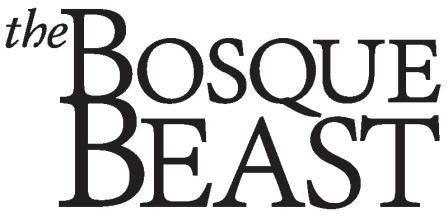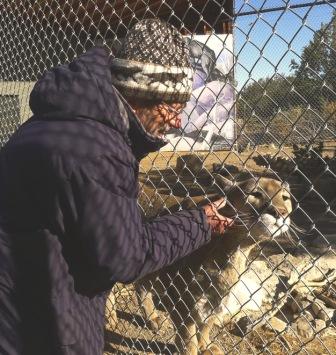
Teaching respect for nature
in an unusual classroom park
It’s a zoo that isn’t quite a zoo. It’s more like a wildlife refuge, except the animals aren’t running around wild. Technically it’s a sanctuary, since the animals are all rescues that cannot be released — but “zoo” is the unfortunate category remaining to describe the fact that the residents all live within exhibits. Wildlife West Nature Park is in a class by itself, a hybrid entertainment complex that is part sanctuary, part educational facility — and wholly the realization of one man’s tailor-made dream.
Roger Alink is an unusual man, and his is not the typical dream. At one time he may have thought about making some money, because he got into commercial real estate after about ten years of teaching industrial arts (shop) at Valley High School in Albuquerque. But then his life fell to pieces — as he puts it — and the suddenly single dad came up with a quite different plan for the 122 acres he had bought with a partner off I-40 in Edgewood.
“It’s all the things I like to do — construction, animals, youth — and that I find valuable,” Alink says of the resulting scheme, smiling from the depths of a voluminous parka on this first icy day of winter. “I wanted to do something I find meaningful. The original business plan (from 1992) is very much like this,” he says, indicating the artificially natural realm he oversees from his tower office.
Alink has never made a dime off of Wildlife West; 20 years later, he’s still a volunteer. Over the decades, the park has added all manner of commercial undertakings to pay the bills: Chuckwagon Suppers every Saturday in summer, a threeday music festival in June, a blacksmithing competition, mud races, and tractor drives among them. All the money raised goes to support the 40-some resident animals, nearly all of them on permanent loan from the New Mexico Department of Game & Fish.
Visitors guide themselves through the 24 stations of the park, a hidden gem of hand-painted signs, reclaimed buildings, and hand-built habitats, all of it constructed by a crew of teens, many from the Youth Conservation Corps, under Alink’s tutelage — along with the occasional offender working off community service time.
“The youth portion (of the plan) has grown because of the YCC,” he explains. “We’ve gotten grants to have about 25 kids each summer. That’s added value to what we’re doing.” He estimates the park has employed about 500 youths, half of them paid by the New Mexico YCC.
Growing up on a Minnesota farm, Alink saw the value of teaching young people to work with their hands, and to learn solid rural values like sustainability, responsibility, and a connection to nature. He guides his youthful crew in adding an exhibit or two each summer, including such priceless oddities as the Pinto Bean Museum — a collection of memorabilia, antiques, and a homemade diorama that pay tribute to the region’s history as the Pinto Bean Capital of America. Local history, Alink says, complements the natural history of New Mexico provided by the animals.
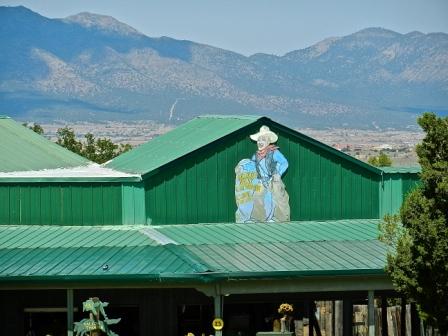
Indeed, where else can you see the local fauna up close? As common as they may be, few city folk ever come across a bobcat, gray wolf, mountain lion, or javelina. And since many of these animals were rescued precisely because they were too socialized with humans (as illegal pets, for example), they are far more responsive to visitors than their wild cousins. That makes for a less depressing experience than the typical zoo.
Alink makes it a point to see that his animals get all the mental stimulation, affection, quality feed, and veterinary care of a beloved family dog — except for the wolves, which are kept as close as possible to wild. The two females and three males don’t even have names. “They’re endangered,” Alink says, implying that it’s best they live free of any more human interference. Nonetheless, they run up to the fence full of curiosity and excitement at the prospect of visitors.
The black bear, Koshari, is a more typical resident. As a baby, he was a food-scavenging nuisance at Navajo Lake, and had to be removed. “He was an emaciated young bear when they got him,” Alink chuckles, indicating the mountain of black fur nodding in its cage, unable to resist the climatic summons to hibernate. A whole fish lies untouched on the ground, and the bear can hardly rouse himself for two giant dog biscuits slathered with peanut butter.
Likewise Phantom, one of the two mountain lions, appears more fat house cat than man-eater. At 15, he has outlived any wild cougar, and probably couldn’t outrun his dinner. Cared for at home by Alink as a sick cub, he purrs like mad when the zookeeper sneaks past the glass enclosure to rub the feline’s neck — something no one else is allowed to try.
In fact, everything at Wildlife West is touched by the spell of Alink’s sincerity, from the well-cared-for animals to the painstakingly constructed habitats, which mimic the naturalistic sculpture of zoo habitats. “They’re old tires covered with stucco,” Alink confides about the javelina enclosure. “Made by the kids.”
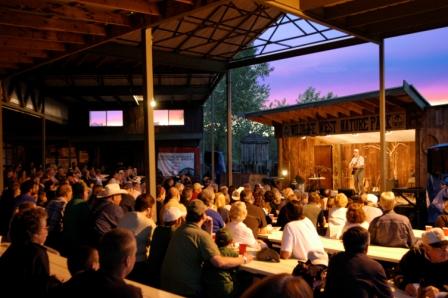
There’s the little Town of Venus, a reconstructed movie-set version of Edgewood, and a central amphitheater made from a garden center that was trucked and reassembled here over the course of three years, where the Chuckwagon Suppers are held.
The park can’t really be called a rescue facility, because it turns away more animals than it accepts. “We are very careful to be sustainable,” Alink says. “Our mission is education, so ten mountain lions is not better than two. We take representative animals who will advocate for the others.
“I get calls every week asking to take animals, because there are not many organizations like ours.” Most wildlife rescues deal in rehabilitation and release — such as the Wildlife Center in Espanola, and its founder Dr. Kathleen Ramsey, the source for two resident elks orphaned by the 2011 Las Conchas fire.
The park’s financial operations reflect a similar thoughtful creativity. “When I formed the nonprofit 20 years ago,” Alink says, “I got a zoo license, water rights, and put together with a lawyer the concept to not pay for any of it, but to do it grassroots.”
He syndicated the land — a mechanism whereby ownership was sold to 35 partners who cannot individually sell. The money raised helped pay for development of the park. Thirty acres of the original holding were sold to the county as open space, zoned commercial, which paid off what was owed on the land. “The nonprofit has a perpetual lease from the partnership for the land,” Alink explains. “It’s a symbiotic relationship.” The park pays for itself through admission, events, and rentals.
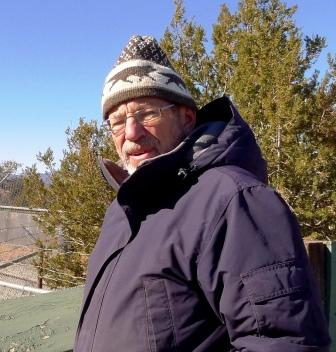
The arrangement leaves Alink free to focus on his mission, which is ensuring that the animals are healthy, visitors have an informative and entertaining experience, and the 40 or 50 volunteers feel appreciated — like Art, who is spending four hours here staffing the visitor center on a day when no one is likely to brave the chill. “Of the donations, probably 99 percent of it goes back to upkeep of the park,” Art says proudly.
The only thing missing from the plan is a salary for the founder, the park’s only full-time volunteer. “I got remarried to an angel,” Alink explains. “She pays the bills.” His main concern right now is making sure his Eden survives him. “Because I’m the glue, I need an exit plan,” he worries. “I need the public to feel the value of what we’re doing.”
The park has already met Alink’s criteria for success, accomplishing its mission of education, caring for wildlife, and helping kids. “It’s a labor of love,” he says. And love is clearly the currency that rewards the volunteers, nourishes the ark, and fulfills its founder’s dream.
